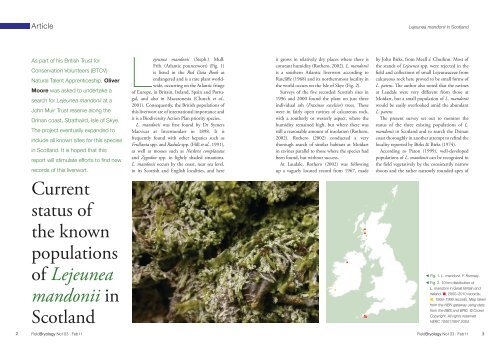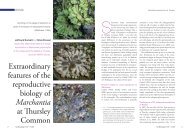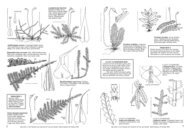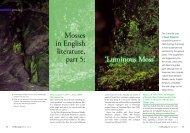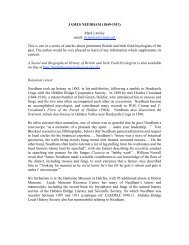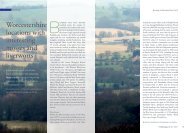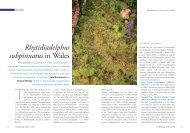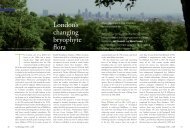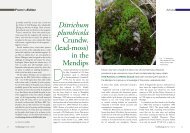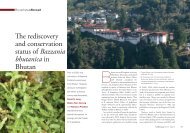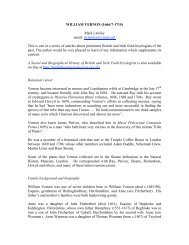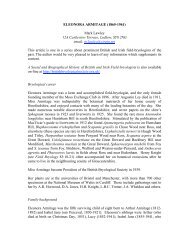Current status of the known populations of Lejeunea mandonii in ...
Current status of the known populations of Lejeunea mandonii in ...
Current status of the known populations of Lejeunea mandonii in ...
You also want an ePaper? Increase the reach of your titles
YUMPU automatically turns print PDFs into web optimized ePapers that Google loves.
2<br />
Article<br />
As part <strong>of</strong> his British Trust for<br />
Conservation Volunteers (BTCV)<br />
Natural Talent Apprenticeship, Oliver<br />
Moore was asked to undertake a<br />
search for <strong>Lejeunea</strong> <strong>mandonii</strong> at a<br />
John Muir Trust reserve along <strong>the</strong><br />
Dr<strong>in</strong>an coast, Strathaird, Isle <strong>of</strong> Skye.<br />
The project eventually expanded to<br />
<strong>in</strong>clude all <strong>known</strong> sites for this species<br />
<strong>in</strong> Scotland. It is hoped that this<br />
report will stimulate efforts to f<strong>in</strong>d new<br />
records <strong>of</strong> this liverwort.<br />
<strong>Current</strong><br />
<strong>status</strong> <strong>of</strong><br />
<strong>the</strong> <strong>known</strong><br />
<strong>populations</strong><br />
<strong>of</strong> <strong>Lejeunea</strong><br />
<strong>mandonii</strong> <strong>in</strong><br />
Scotland<br />
FieldBryology No103 | Feb11<br />
<strong>Lejeunea</strong> <strong>mandonii</strong> (Steph.) Mull.<br />
Frib. (Atlantic pouncewort) (Fig. 1)<br />
is listed <strong>in</strong> <strong>the</strong> Red Data Book as<br />
endangered and is a rare plant worldwide,<br />
occurr<strong>in</strong>g on <strong>the</strong> Atlantic fr<strong>in</strong>ge<br />
<strong>of</strong> Europe, <strong>in</strong> Brita<strong>in</strong>, Ireland, Spa<strong>in</strong> and Portu-<br />
gal, and also <strong>in</strong> Macaronesia (Church et al.,<br />
2001). Consequently, <strong>the</strong> British <strong>populations</strong> <strong>of</strong><br />
this liverwort are <strong>of</strong> <strong>in</strong>ternational importance and<br />
it is a Biodiversity Action Plan priority species.<br />
L. <strong>mandonii</strong> was first found by Dr Symers<br />
Macvicar at Invermoidart <strong>in</strong> 1898. It is<br />
frequently found with o<strong>the</strong>r hepatics such as<br />
Frullania spp. and Radula spp. (Hill et al., 1991),<br />
as well as mosses such as Neckera complanata<br />
and Zygodon spp. <strong>in</strong> lightly shaded situations.<br />
L. <strong>mandonii</strong> occurs by <strong>the</strong> coast, near sea level,<br />
<strong>in</strong> its Scottish and English localities, and here<br />
it grows <strong>in</strong> relatively dry places where <strong>the</strong>re is<br />
constant humidity (Ro<strong>the</strong>ro, 2002). L. <strong>mandonii</strong><br />
is a sou<strong>the</strong>rn Atlantic liverwort accord<strong>in</strong>g to<br />
Ratcliffe (1968) and its nor<strong>the</strong>rnmost locality <strong>in</strong><br />
<strong>the</strong> world occurs on <strong>the</strong> Isle <strong>of</strong> Skye (Fig. 2).<br />
Surveys <strong>of</strong> <strong>the</strong> five recorded Scottish sites <strong>in</strong><br />
1996 and 2000 found <strong>the</strong> plant on just three<br />
<strong>in</strong>dividual ash (Frax<strong>in</strong>us excelsior) trees. These<br />
were <strong>in</strong> fairly open rav<strong>in</strong>es <strong>of</strong> calcareous rock,<br />
with a sou<strong>the</strong>rly or westerly aspect, where <strong>the</strong><br />
humidity rema<strong>in</strong>ed high, but where <strong>the</strong>re was<br />
still a reasonable amount <strong>of</strong> <strong>in</strong>solation (Ro<strong>the</strong>ro,<br />
2002). Ro<strong>the</strong>ro (2002) conducted a very<br />
thorough search <strong>of</strong> similar habitats at Moidart<br />
<strong>in</strong> rav<strong>in</strong>es parallel to those where <strong>the</strong> species had<br />
been found, but without success.<br />
At Laudale, Ro<strong>the</strong>ro (2002) was follow<strong>in</strong>g<br />
up a vaguely located record from 1967, made<br />
<strong>Lejeunea</strong> <strong>mandonii</strong> <strong>in</strong> Scotland<br />
by John Birks, from Meall a’ Chuil<strong>in</strong>n. Most <strong>of</strong><br />
<strong>the</strong> stands <strong>of</strong> <strong>Lejeunea</strong> spp. were rejected <strong>in</strong> <strong>the</strong><br />
field and collections <strong>of</strong> small <strong>Lejeunea</strong>ceae from<br />
calcareous rock here proved to be small forms <strong>of</strong><br />
L. patens. The author also noted that <strong>the</strong> rav<strong>in</strong>es<br />
at Laudale were very different from those at<br />
Moidart, but a small population <strong>of</strong> L. <strong>mandonii</strong><br />
would be easily overlooked amid <strong>the</strong> abundant<br />
L. patens.<br />
The present survey set out to monitor <strong>the</strong><br />
<strong>status</strong> <strong>of</strong> <strong>the</strong> three exist<strong>in</strong>g <strong>populations</strong> <strong>of</strong> L.<br />
<strong>mandonii</strong> <strong>in</strong> Scotland and to search <strong>the</strong> Dr<strong>in</strong>an<br />
coast thoroughly <strong>in</strong> ano<strong>the</strong>r attempt to ref<strong>in</strong>d <strong>the</strong><br />
locality reported by Birks & Birks (1974).<br />
Accord<strong>in</strong>g to Paton (1999), well-developed<br />
<strong>populations</strong> <strong>of</strong> L. <strong>mandonii</strong> can be recognized <strong>in</strong><br />
<strong>the</strong> field vegetatively by <strong>the</strong> consistently narrow<br />
shoots and <strong>the</strong> ra<strong>the</strong>r narrowly rounded apex <strong>of</strong><br />
b Fig. 1. L. <strong>mandonii</strong>. F. Rumsey.<br />
b Fig. 2. 10 km distribution <strong>of</strong><br />
L. <strong>mandonii</strong> <strong>in</strong> Great Brita<strong>in</strong> and<br />
Ireland. j, 2000–2010 records;<br />
j, 1959–1999 records. Map taken<br />
from <strong>the</strong> NBN gateway us<strong>in</strong>g data<br />
from <strong>the</strong> BBS and BRC. © Crown<br />
Copyright. All rights reserved<br />
NERC 100017897 2004<br />
FieldBryology No103 | Feb11 3
More acute apex to leaf<br />
lobes (but sometimes folded<br />
below) and narrow shoots<br />
More acute angle<br />
many <strong>of</strong> <strong>the</strong> leaves. L. <strong>mandonii</strong> is <strong>the</strong> only British<br />
member <strong>of</strong> <strong>the</strong> genus that has terete, smooth<br />
perianths, but <strong>the</strong>se may be very small and are<br />
<strong>the</strong>n not always easily located <strong>in</strong> <strong>the</strong> field (Paton,<br />
1999). Capsules are reported as be<strong>in</strong>g very rare,<br />
occurr<strong>in</strong>g <strong>in</strong> <strong>the</strong> spr<strong>in</strong>g (Holyoak, 2004), and<br />
perianths are occasional (Smith, 1990). There<br />
is no specialized means <strong>of</strong> vegetative spread<br />
(Ro<strong>the</strong>ro, 2002).<br />
Confusion species <strong>in</strong> <strong>the</strong> field <strong>in</strong>clude L. patens<br />
and Harpalejeunea molleri, both <strong>of</strong> which may<br />
grow with L. <strong>mandonii</strong>, mak<strong>in</strong>g th<strong>in</strong>gs very difficult<br />
(Ro<strong>the</strong>ro, 2002). H. molleri differs <strong>in</strong> its<br />
underleaves and more acute leaf lobes, while <strong>in</strong><br />
L. patens <strong>the</strong> angle between <strong>the</strong> postical marg<strong>in</strong><br />
and <strong>the</strong> keel is narrower (Paton, 1999). L. patens<br />
has a more broadly rounded leaf apex compared<br />
to its rarer congener. Fig. 3 illustrates some <strong>of</strong><br />
<strong>the</strong> differences between <strong>the</strong> species mentioned<br />
above. It should be added that shaded stems <strong>of</strong> L.<br />
lamacer<strong>in</strong>a, L. patens and L. cavifolia can produce<br />
leaves that are longer than usual (Holyoak, 2004)<br />
and when occurr<strong>in</strong>g on small specimens <strong>of</strong> <strong>the</strong>se<br />
species, dist<strong>in</strong>guish<strong>in</strong>g <strong>the</strong>m from L. <strong>mandonii</strong> is<br />
even more difficult.<br />
Broadly rounded apex to<br />
leaf lobes and usually larger<br />
shoots<br />
Narrowly rounded apex<br />
to leaf lobes and narrow<br />
shoots<br />
m Fig. 3. Illustrations <strong>of</strong> some possible confusion species. From left to right: H. molleri, L. lamacer<strong>in</strong>a, L. patens and<br />
L. <strong>mandonii</strong>. Postical view (upper row) and antical view (lower row). Magnification x40. O. Moore<br />
Procedure<br />
Herbarium specimens <strong>of</strong> L. <strong>mandonii</strong>, L.<br />
cavifolia, L. lamacer<strong>in</strong>a, L. patens, H. molleri and<br />
Drepanolejeunea hamatifolia were scrut<strong>in</strong>ized<br />
at <strong>the</strong> Royal Botanic Garden, Ed<strong>in</strong>burgh, <strong>in</strong><br />
preparation for field work. In order to become<br />
acqua<strong>in</strong>ted with <strong>the</strong> target liverwort <strong>in</strong> <strong>the</strong><br />
field, a site visit to one <strong>of</strong> its <strong>known</strong> locations at<br />
Tokavaig was undertaken on 27 February 2010.<br />
On 1 March 2010, Nick Hodgetts jo<strong>in</strong>ed me <strong>in</strong><br />
<strong>the</strong> field on a spectacular day to beg<strong>in</strong> <strong>the</strong> search<br />
for this elusive liverwort <strong>in</strong> sea caves along <strong>the</strong><br />
Dr<strong>in</strong>an coast (Fig. 4). A few days before, by<br />
means <strong>of</strong> an open canoe, a 3-km stretch <strong>of</strong> coast<br />
had been viewed to see which sea caves showed<br />
<strong>the</strong> greatest potential to search <strong>in</strong>.<br />
Accord<strong>in</strong>g to Birks & Birks (1974), L. <strong>mandonii</strong><br />
was said to be very rare (on Skye), restricted to<br />
a s<strong>in</strong>gle locality <strong>in</strong> <strong>the</strong> Elgol Pen<strong>in</strong>sula where<br />
it occurs with Marches<strong>in</strong>ia mackaii on dry but<br />
shaded Jurassic limestone rocks <strong>in</strong> a large sea cave.<br />
Ro<strong>the</strong>ro (2002) tracked down Birks’ notes from<br />
his orig<strong>in</strong>al discovery and was able to add ‘…<br />
somewhere between grid reference 18/553 160 and<br />
18/548 147’. Dur<strong>in</strong>g <strong>the</strong> search, a vast amount<br />
m Fig. 4. Dr<strong>in</strong>an coast with view north to <strong>the</strong> Red Cuill<strong>in</strong>s.<br />
O. Moore<br />
<strong>of</strong> M. mackaii was exam<strong>in</strong>ed, and every smallleaved<br />
patch <strong>of</strong> L. patens was studied carefully.<br />
A small amount <strong>of</strong> material was collected for<br />
check<strong>in</strong>g with a microscope.<br />
Dur<strong>in</strong>g <strong>the</strong> next couple <strong>of</strong> weeks, visits were<br />
made to different coastal gullies, sea caves and<br />
wooded rav<strong>in</strong>es along this stretch <strong>of</strong> coast, and<br />
beyond <strong>the</strong> area specified by Birks & Birks<br />
(1974).<br />
On 5, 19 and 20 March 2010, visits were<br />
made to <strong>the</strong> <strong>known</strong> locations for L. <strong>mandonii</strong> at<br />
Tokavaig (Skye), Allt Aile<strong>in</strong> and Allt a’ Mhuill<strong>in</strong><br />
(Moidart), respectively. At each site <strong>the</strong> distribution<br />
<strong>of</strong> <strong>the</strong> liverwort was mapped onto a sketch<br />
<strong>of</strong> <strong>the</strong> relevant facies <strong>of</strong> <strong>the</strong> tree. An estimate <strong>of</strong><br />
<strong>the</strong> area <strong>of</strong> each patch, or extent <strong>of</strong> <strong>the</strong> scattered<br />
shoots, was made us<strong>in</strong>g a transparent overlay with<br />
1 cm grid squares marked on. The total area on<br />
each tree was calculated by add<strong>in</strong>g up all <strong>of</strong> <strong>the</strong>se<br />
values (Table 1). Accurate grid references were<br />
determ<strong>in</strong>ed with a GPS device and photographs<br />
<strong>of</strong> <strong>the</strong> trees and habitat were taken for future<br />
reference. A search <strong>of</strong> o<strong>the</strong>r suitable habitat <strong>in</strong><br />
each <strong>of</strong> <strong>the</strong>se rav<strong>in</strong>es was made to try and f<strong>in</strong>d<br />
o<strong>the</strong>r <strong>populations</strong> <strong>of</strong> L. <strong>mandonii</strong>. A bad wea<strong>the</strong>r<br />
forecast limited my search to just one o<strong>the</strong>r<br />
adjacent rav<strong>in</strong>e (Limekiln Burn) at Moidart.<br />
Observations<br />
Fig. 5 gives a crude idea <strong>of</strong> <strong>the</strong> extent <strong>of</strong> L.<br />
<strong>mandonii</strong> <strong>populations</strong> at its <strong>known</strong> localities <strong>in</strong><br />
Scotland. More accurate and detailed mapp<strong>in</strong>g<br />
<strong>of</strong> <strong>the</strong> distribution <strong>of</strong> this species onto sketches <strong>of</strong><br />
Table 1. Total area <strong>of</strong> patches and/or scattered shoots <strong>of</strong> L. <strong>mandonii</strong> on different aspects <strong>of</strong> <strong>the</strong> three ash trees<br />
on which it occurs <strong>in</strong> Scotland<br />
Date Location Area (cm 2 ) <strong>of</strong> patches/scattered shoots on tree-faces<br />
N-fac<strong>in</strong>g NE-fac<strong>in</strong>g W-fac<strong>in</strong>g S-fac<strong>in</strong>g<br />
5/3/10 Tokavaig 210 – 21 12<br />
19/3/10 Allt Aile<strong>in</strong> 208 28 – –<br />
20/3/10 Allt a’ Mhuill<strong>in</strong> – 18 – –<br />
4 FieldBryology No103 | Feb11 FieldBryology No103 | Feb11 5
(a)<br />
Table 2. Total area <strong>of</strong> L. <strong>mandonii</strong> from <strong>the</strong> three ash trees on which it occurs <strong>in</strong><br />
Scotland <strong>in</strong> 2010 compared with that estimated by Ro<strong>the</strong>ro (2002) <strong>in</strong> 2000<br />
Location Estimated total area (cm 2 ) <strong>of</strong> scattered shoots/patches <strong>of</strong><br />
L. <strong>mandonii</strong><br />
2000 2010<br />
Tokavaig Approx. 150 233<br />
Allt Aile<strong>in</strong> Might approach 600 236<br />
Allt a’ Mhuill<strong>in</strong> Not more than 30 18<br />
(b)<br />
(c)<br />
b Fig. 5. Distribution <strong>of</strong> L. <strong>mandonii</strong> on some <strong>of</strong> <strong>the</strong><br />
ash trees observed <strong>in</strong> this study. (a) North-fac<strong>in</strong>g<br />
side (Tokavaig, lower trunk); (b) north-east face (Allt<br />
a’ Mhuill<strong>in</strong>); (c) north-face (Allt Aile<strong>in</strong>, lower trunk).<br />
O. Moore<br />
<strong>the</strong> trees gave <strong>the</strong> total estimated areas as shown<br />
<strong>in</strong> Tables 1 and 2. Table 2 also <strong>in</strong>cludes <strong>the</strong> areas<br />
estimated by Ro<strong>the</strong>ro (2002). Despite a great<br />
deal <strong>of</strong> effort, L. <strong>mandonii</strong> was not found along<br />
<strong>the</strong> Dr<strong>in</strong>an coast or <strong>in</strong> potential locations fur<strong>the</strong>r<br />
south. No new <strong>populations</strong> were discovered <strong>in</strong><br />
Allt Aile<strong>in</strong>, Allt a’ Mhuill<strong>in</strong> or Limekiln Burn.<br />
Conclusions<br />
Ro<strong>the</strong>ro (2002) po<strong>in</strong>ts out that L. <strong>mandonii</strong> was<br />
<strong>in</strong>timately mixed with o<strong>the</strong>r <strong>Lejeunea</strong>ceae at <strong>the</strong><br />
Scottish sites, mak<strong>in</strong>g accurate assessments <strong>of</strong><br />
population size difficult without much damage<br />
to <strong>the</strong> stands. No specimens were collected<br />
from <strong>the</strong> <strong>known</strong> <strong>populations</strong> <strong>in</strong> this survey and<br />
estimates <strong>of</strong> population size were entirely <strong>the</strong><br />
result <strong>of</strong> close scrut<strong>in</strong>y <strong>of</strong> <strong>the</strong> epiphytes <strong>in</strong> situ.<br />
The ma<strong>in</strong> disparity between <strong>the</strong> total area <strong>of</strong><br />
L. <strong>mandonii</strong> estimated <strong>in</strong> <strong>the</strong> present survey and<br />
that <strong>of</strong> Ro<strong>the</strong>ro (2002) occurred at Allt Aile<strong>in</strong>,<br />
with nearly three times less measured <strong>in</strong> 2010.<br />
However, patches <strong>of</strong> L. <strong>mandonii</strong> still occur over<br />
some 2 m <strong>of</strong> <strong>the</strong> tree trunk (Fig. 5c) as <strong>the</strong>y did <strong>in</strong><br />
<strong>the</strong> 2000 survey. Ro<strong>the</strong>ro (2002) concedes that it<br />
was just possible that some <strong>of</strong> <strong>the</strong> stands recorded<br />
were small forms <strong>of</strong> L. patens, but this could not<br />
be <strong>in</strong>vestigated without an unwarranted level <strong>of</strong><br />
collection. In <strong>the</strong> present survey, <strong>the</strong>se stands<br />
might well have been taken for <strong>the</strong> commoner<br />
species, result<strong>in</strong>g <strong>in</strong> a lower estimate <strong>of</strong> cover for<br />
L. <strong>mandonii</strong>.<br />
Holyoak (2000) suggested that <strong>the</strong>re might<br />
be a relationship between <strong>the</strong> vigour and growth<br />
<strong>of</strong> L. <strong>mandonii</strong> and <strong>the</strong> growth, persistence<br />
and decay <strong>of</strong> <strong>the</strong> mosses on which it usually<br />
grows. Therefore, <strong>the</strong> year to year variation <strong>in</strong><br />
abundance could be a natural phenomenon<br />
and not a cause for concern. This went with<br />
<strong>the</strong> proviso that fur<strong>the</strong>r <strong>in</strong>vestigation would<br />
be needed to test this hypo<strong>the</strong>sis. Anecdotal<br />
evidence <strong>in</strong> support <strong>of</strong> this suggestion comes<br />
with <strong>the</strong> observation that <strong>the</strong> population <strong>of</strong> L.<br />
<strong>mandonii</strong> on <strong>the</strong> ash tree at Tokavaig appears to<br />
have moved around quite a bit over <strong>the</strong> years<br />
(N. Hodgetts, pers. comm.). Some evidence <strong>of</strong><br />
sloughed bryophyte cover was observed at this<br />
site and it is possible that some <strong>of</strong> <strong>the</strong> patches<br />
recorded by Ro<strong>the</strong>ro (2002) had been lost as a<br />
result. L. <strong>mandonii</strong> is a brittle plant and it may<br />
well be susceptible to damage from ra<strong>in</strong>drops or<br />
mov<strong>in</strong>g water (Holyoak, 2004), so a powerful<br />
ra<strong>in</strong>fall event may have caused a loss to <strong>the</strong><br />
population <strong>in</strong> <strong>the</strong> last 10 years. There were fewer<br />
patches found down <strong>the</strong> north-east aspect <strong>of</strong> <strong>the</strong><br />
tree at Allt Aile<strong>in</strong> compared to 10 years previously<br />
(Ro<strong>the</strong>ro, 2002); this may have been due to a<br />
storm event. Follow<strong>in</strong>g annual repetition <strong>of</strong> <strong>the</strong><br />
measurements <strong>of</strong> patches from 1997 to 2003/4<br />
at Cornish localities for L. <strong>mandonii</strong>, <strong>the</strong>re<br />
were erratic fluctuations at most sites (Holyoak,<br />
2004). Maybe a similar fluctuation is occurr<strong>in</strong>g<br />
<strong>in</strong> <strong>the</strong> Allt Aile<strong>in</strong> population.<br />
There appears to have been an <strong>in</strong>crease <strong>in</strong> cover<br />
<strong>of</strong> L. <strong>mandonii</strong> at Tokavaig and a decrease at Allt<br />
a’ Mhuill<strong>in</strong>. The bulk <strong>of</strong> <strong>the</strong> <strong>populations</strong> <strong>of</strong> L.<br />
<strong>mandonii</strong> <strong>in</strong> Scotland occur on <strong>the</strong> north/north-<br />
<strong>Lejeunea</strong> <strong>mandonii</strong> <strong>in</strong> Scotland<br />
east-fac<strong>in</strong>g aspects <strong>of</strong> ash trunks (Table 1). The<br />
best patches were found beneath branches on <strong>the</strong><br />
trunk. Holyoak (2004) suggests that limitation<br />
to <strong>the</strong>se places may be due to avoidance <strong>of</strong><br />
competition from <strong>the</strong> vigorous growth <strong>of</strong> pleurocarpous<br />
mosses. S<strong>in</strong>ce L. <strong>mandonii</strong> obta<strong>in</strong>s<br />
all <strong>of</strong> its water from humid air, this must be<br />
characteristic <strong>of</strong> <strong>the</strong> sites where it occurs. The<br />
aspects where it occurs, however, would generally<br />
confer drier and more shaded conditions for this<br />
liverwort.<br />
The fact that L. <strong>mandonii</strong> is only <strong>known</strong> from<br />
just three ash trees makes this species extremely<br />
threatened <strong>in</strong> Scotland. Ro<strong>the</strong>ro (2002) expressed<br />
his concerns about <strong>the</strong> ivy on <strong>the</strong> ash at<br />
Tokavaig and this could yet become a problem,<br />
but at present <strong>the</strong> L. <strong>mandonii</strong> population<br />
appears to be do<strong>in</strong>g well here. Competition from<br />
more robust bryophytes was a concern at Allt<br />
a’ Mhuill<strong>in</strong> (Ro<strong>the</strong>ro, 2002) where <strong>the</strong> L.<br />
<strong>mandonii</strong> population is very small. This population<br />
does appear to have decl<strong>in</strong>ed. At Allt<br />
Aile<strong>in</strong>, Ro<strong>the</strong>ro (2002) commented on <strong>the</strong><br />
ra<strong>the</strong>r sorry-look<strong>in</strong>g ash tree that holds a good<br />
population <strong>of</strong> L. <strong>mandonii</strong>. The tree still rema<strong>in</strong>s<br />
<strong>in</strong> 2010. Rhododendron ponticum was not seen <strong>in</strong><br />
<strong>the</strong> vic<strong>in</strong>ity <strong>of</strong> any <strong>of</strong> <strong>the</strong> three sites, but it does<br />
occur to <strong>the</strong> east <strong>of</strong> Allt a’ Mhuill<strong>in</strong>. At present<br />
<strong>the</strong>re is no immediate risk <strong>of</strong> shad<strong>in</strong>g by this<br />
species.<br />
All three trees are close to a stream edge <strong>in</strong><br />
steep-sided, rocky rav<strong>in</strong>es and may be prone to<br />
an extreme ra<strong>in</strong>fall event caus<strong>in</strong>g bank collapse<br />
or large debris be<strong>in</strong>g washed downstream. Such<br />
an event could be catastrophic to any species with<br />
so restricted a population. Ro<strong>the</strong>ro (2002) urged<br />
research <strong>in</strong>to <strong>the</strong> ex situ cultivation <strong>of</strong> L. <strong>mandonii</strong>,<br />
with a view to transplantation <strong>in</strong>to a suitable<br />
habitat. This proactive measure might ensure <strong>the</strong><br />
survival <strong>of</strong> this liverwort at <strong>the</strong> nor<strong>the</strong>rn limits<br />
<strong>of</strong> its range. More regular monitor<strong>in</strong>g <strong>of</strong> <strong>the</strong>se<br />
6 FieldBryology No103 | Feb11 FieldBryology No103 | Feb11 7
<strong>Lejeunea</strong> <strong>mandonii</strong> <strong>in</strong> Scotland<br />
<strong>populations</strong> is recommended so that decisions<br />
concern<strong>in</strong>g conservation strategy can be made<br />
quickly <strong>in</strong> <strong>the</strong> event <strong>of</strong> disaster.<br />
Dur<strong>in</strong>g <strong>the</strong> preparation <strong>of</strong> this report, Birks’<br />
herbarium arrived at <strong>the</strong> RBGE and conta<strong>in</strong>ed<br />
two specimens <strong>of</strong> L. <strong>mandonii</strong>, both from <strong>the</strong><br />
Dr<strong>in</strong>an coast, Skye. Each had been refereed<br />
successfully. One specimen was collected on 2<br />
July 1967 and <strong>the</strong> o<strong>the</strong>r on 9 August 1968. In<br />
each case it had been grow<strong>in</strong>g with M. mackaii<br />
and <strong>the</strong> latter collection was from a shaded sea<br />
<strong>in</strong>let near Kilmarie. However, <strong>the</strong>re was no<br />
accurate grid reference. Even after considerable<br />
time spent on unsuccessful searches <strong>of</strong> <strong>the</strong><br />
Dr<strong>in</strong>an coast dur<strong>in</strong>g this survey and by o<strong>the</strong>rs<br />
(Ro<strong>the</strong>ro, 2002; Averis 1995), it is still possible<br />
a few shoots <strong>of</strong> this t<strong>in</strong>y liverwort could have<br />
escaped detection.<br />
S<strong>in</strong>ce all <strong>of</strong> <strong>the</strong> sites where L. <strong>mandonii</strong> occurs<br />
have enjoyed relative stability for centuries,<br />
Holyoak (2004) suggests <strong>the</strong>re is a need for<br />
historically stable habitats with<strong>in</strong> <strong>the</strong> Atlantic<br />
climate zone <strong>in</strong> order for this liverwort to grow.<br />
Bryologists are urged to keep an eye out for this<br />
rarity whenever <strong>the</strong>y f<strong>in</strong>d <strong>the</strong>mselves <strong>in</strong> humid<br />
rav<strong>in</strong>es with overhang<strong>in</strong>g, basic rocks and old<br />
woodland with ash trees <strong>in</strong> Scotland.<br />
Oliver Moore<br />
The Stonemans, Letterewe, Achnasheen,<br />
Ross-shire IV22 2HH (e bloaterol@yahoo.com)<br />
Acknowledgements<br />
I wish to thank Liz Auty for <strong>in</strong>vit<strong>in</strong>g me to carry out work for<br />
<strong>the</strong> John Muir Trust and for her support dur<strong>in</strong>g my placement.<br />
Thanks also to <strong>the</strong> John Muir Trust team at <strong>the</strong> Skye <strong>of</strong>fice for<br />
putt<strong>in</strong>g up with me for several weeks. I am grateful to Lester<br />
Standen for tak<strong>in</strong>g me out on <strong>the</strong> open canoe to look at <strong>the</strong><br />
sea caves at <strong>the</strong> beg<strong>in</strong>n<strong>in</strong>g <strong>of</strong> this quest. Nick Hodgetts spared<br />
8 FieldBryology No103 | Feb11<br />
time to help with <strong>the</strong> search along <strong>the</strong> Dr<strong>in</strong>an coast and gave<br />
useful guidance concern<strong>in</strong>g this report. The encouragement I<br />
received from my mentors, David Long and Liz Kungu from<br />
<strong>the</strong> RBGE, fired my enthusiasm at <strong>the</strong> start <strong>of</strong> this project.<br />
Thanks also to Gordon Ro<strong>the</strong>ro for his <strong>in</strong>valuable advice and<br />
<strong>in</strong>terest. Sally Rae k<strong>in</strong>dly located <strong>the</strong> L. <strong>mandonii</strong> specimens<br />
from Birks’ herbarium at <strong>the</strong> RBGE. This survey would not<br />
have been possible without <strong>the</strong> f<strong>in</strong>ancial support <strong>of</strong> <strong>the</strong> BTCV<br />
Natural Talent Scheme (through Heritage Lottery Fund<strong>in</strong>g). I<br />
was thrilled to receive a John Muir Award (Conserver Level)<br />
with <strong>the</strong> publication <strong>of</strong> this article.<br />
References<br />
Averis, B. (1995). A Botanical Survey <strong>of</strong> <strong>the</strong> Woods <strong>of</strong> <strong>the</strong> Elgol-<br />
Torr<strong>in</strong> Area, Skye. Unpublished.<br />
Birks, H.J.B. & Birks, H.H. (1974). Studies on <strong>the</strong> bryophyte<br />
flora and vegetation <strong>of</strong> <strong>the</strong> Isle <strong>of</strong> Skye. I. Journal <strong>of</strong> Bryology<br />
8, 19–64, 197–254.<br />
Church, J.M., Hodgetts, N.G., Preston, C.D. & Stewart,<br />
N.F. (2001). British Red Data Books. Mosses and Liverworts.<br />
Peterborough: Jo<strong>in</strong>t Nature Conservancy Council.<br />
Hill, M.O., Preston, C.D. & Smith, A.J.E. (1991). Atlas <strong>of</strong><br />
<strong>the</strong> Bryophytes <strong>of</strong> Brita<strong>in</strong> and Ireland, Vol. 1, Liverworts.<br />
Colchester: Harley Books.<br />
Holyoak, D.T. (2000). Atlantic lejeunea (<strong>Lejeunea</strong> <strong>mandonii</strong>).<br />
Report on work carried out dur<strong>in</strong>g 1999 and summary<br />
<strong>of</strong> results <strong>of</strong> work dur<strong>in</strong>g 1997 and 1998. Plantlife – back<br />
from <strong>the</strong> Br<strong>in</strong>k Project/English Nature – Species Recovery<br />
Programme, Report No. 142.<br />
Holyoak, D.T. (2004). <strong>Lejeunea</strong> <strong>mandonii</strong> (Steph.) Mull. Frib.<br />
UK Biodiversity Action Plan. www.plantlife.org.uk/uk/<br />
assets/sav<strong>in</strong>g-species-dossier/<strong>Lejeunea</strong>_<strong>mandonii</strong>_dossier.<br />
pdf<br />
Paton, J.A. (1999). The Liverwort Flora <strong>of</strong> <strong>the</strong> British Isles.<br />
Colchester: Harley Books.<br />
Ratcliffe, D.A. (1968). An ecological account <strong>of</strong> Atlantic<br />
bryophytes <strong>in</strong> <strong>the</strong> British Isles. New Phytologist 67, 365–439.<br />
Ro<strong>the</strong>ro, G.P. (2002). Species dossier: <strong>Lejeunea</strong> <strong>mandonii</strong>.<br />
Unpublished Report for Scottish Natural Heritage.<br />
Smith, A.J.E. (1990). The Liverworts <strong>of</strong> Brita<strong>in</strong> & Ireland.<br />
Cambridge: Cambridge University Press.


